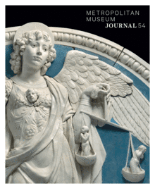
METROPOLITAN MUSEUM JOURNAL
Scope & Guideline
Elevating Conversations in Conservation and Museology
Introduction
Aims and Scopes
- Art Historical Analysis:
The journal emphasizes rigorous art historical methodologies, analyzing works from various periods and cultures to uncover their significance, context, and impact. - Cultural Heritage Studies:
The journal explores themes related to cultural heritage, including the provenance of artworks and the implications of collecting practices, particularly as they pertain to The Met's collections. - Interdisciplinary Approaches:
The journal encourages interdisciplinary research that intersects art history with other fields such as anthropology, archaeology, and material culture studies. - Technical and Material Analysis:
There is a consistent focus on the technical aspects of artworks, including materials, techniques, and conservation issues, contributing to a deeper understanding of artistic production. - Historical Contextualization:
Papers often situate artworks within broader historical narratives, examining their social, political, and economic contexts to enrich the reader's understanding.
Trending and Emerging
- Material Culture and Craftsmanship:
There is an increasing focus on the study of materials and craftsmanship, emphasizing the significance of artisanal practices and the physicality of objects in art historical research. - Postcolonial Perspectives:
Recent publications have begun to incorporate postcolonial theories, examining the legacies of colonialism in art and the dynamics of cultural exchange, particularly in relation to non-Western art. - Intersections of Art and Politics:
The journal has seen a rise in papers exploring the political dimensions of art, particularly how artworks respond to or reflect political contexts and social movements. - Indigenous Art and Representation:
A growing number of publications focus on Indigenous art, addressing themes of representation, identity, and the historical narratives surrounding Indigenous peoples, particularly in relation to The Met’s collections. - Digital Humanities and Art History:
Emerging methodologies that leverage digital tools and technologies for art historical research are gaining traction, reflecting a broader trend towards interdisciplinary collaboration and innovation.
Declining or Waning
- Traditional Portraiture Studies:
Research focused exclusively on traditional portraiture, particularly from earlier historical periods, has become less prevalent, possibly due to a shift toward more contemporary and thematic explorations. - Regional Art Focus:
There appears to be a waning interest in studies that concentrate solely on regional art forms, as the journal increasingly embraces global perspectives and interconnected narratives. - Single-Artist Monographs:
The journal has seen a decline in papers dedicated to single-artist studies, as the trend moves towards more comparative and thematic analyses that incorporate multiple artists and styles. - Historical Collecting Practices:
While still relevant, the frequency of papers specifically examining historical collecting practices has decreased, suggesting a shift towards contemporary discussions of collection ethics and repatriation. - Iconography Studies:
There is a noticeable reduction in the focus on iconography as a standalone theme, with fewer analyses that solely interpret symbols and motifs without broader contextual frameworks.
Similar Journals

Baltic Journal of Art History
Exploring the Rich Tapestry of Baltic Art HistoryBaltic Journal of Art History is a prominent academic journal published by UNIV TARTU PRESS, focusing on the rich tapestry of art historical research within the Baltic region and beyond. With its ISSN 1736-8812 and E-ISSN 2346-5581, the journal serves as a vital platform for scholars, artists, and historians to disseminate innovative findings and critical analyses in the fields of History and Visual Arts and Performing Arts. Established in 2017, it has gained recognition in academic circles, achieving a Q3 ranking in History and a Q2 ranking in Visual Arts and Performing Arts as of 2023. Despite not being open access, the journal continues to attract a diverse readership eager to engage with its rigorous, peer-reviewed content. Situated in Estonia, the journal not only enriches the regional scholarly discourse but also contributes significantly to global conversations on art history. Positioned at a pivotal intersection of various disciplines, the Baltic Journal of Art History invites researchers and practitioners alike to explore the aesthetic and cultural narratives that shape our understanding of art.

Art-Sanat
Championing Open Access to Artistic InsightsArt-Sanat is a distinguished open-access journal published by the Research Institute of Turkology at Istanbul University, focusing on various facets of art history, visual arts, and cultural heritage. Since its open-access launch in 2017, the journal has been dedicated to promoting scholarly communication and disseminating innovative research within the fields of Art History, Archaeology, and Conservation. With an impact factor that highlights its increasing prominence—ranking in the Q1 quartile for History and Visual Arts and Performing Arts—Art-Sanat provides a platform for researchers, professionals, and students to share high-quality studies. The journal's commitment to transparency and accessibility assures that its contributions are available to a global audience, fostering a community of inquiry in the rich and diverse artistic landscapes of Turkey and beyond. With a robust ranking in Scopus, it stands as a noteworthy resource that advances scholarly engagement and interdisciplinary dialogue in the arts and humanities.
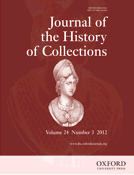
Journal of the History of Collections
Navigating the intricate world of art and artifacts.Journal of the History of Collections, published by Oxford University Press, serves as a vital resource for scholars and practitioners in the fields of conservation, museology, and visual arts. Established in 1989, this esteemed journal explores the intricate narratives of collections, addressing the historical, cultural, and social dynamics that influence collecting practices across various mediums. With an evolving publication span through 1994 and resuming in 1996 to the present day, the journal maintains a strong academic reputation, demonstrated by its impressive rankings in Scopus—placing it in the top quartiles for both Museology and Visual Arts and Performing Arts. Researchers and students will find engaging articles that not only contribute to academic discourse but also reflect on the conservation challenges faced by collections today. While currently not available as open access, the journal’s rigorous peer-review process ensures that only the highest quality research is published, making it an essential addition to any library dedicated to the arts and humanities.

Zivot Umjetnosti
Fostering critical dialogue in the realm of artistic research.Zivot Umjetnosti, published by the INST POVIJEST UMJETNOSTI - INST ART HISTORY, is a notable Croatian journal that serves as a platform for scholarly discourse in the fields of visual arts, performing arts, and museology. With its inception in 2008, the journal has continued to provide a voice for researchers and practitioners alike, contributing significantly to ongoing conversations in the arts. Despite its current Q4 rank in both Visual Arts and Museology categories—placing it within the 21st and 17th percentiles, respectively—Zivot Umjetnosti is recognized for its commitment to advancing knowledge and fostering critical dialogue. The journal aims to bridge theoretical frameworks with practical applications, making it an invaluable resource for academics, curators, and students engaged in artistic research. While currently operating under traditional access options, Zivot Umjetnosti remains a fundamental publication for those wishing to explore and expand their understanding of the dynamic intersection of art and culture in Croatia and beyond.

BURLINGTON MAGAZINE
Connecting Scholars and Enthusiasts in Artistic ExplorationBurlington Magazine is a prestigious scholarly journal dedicated to the study and appreciation of visual arts and performing arts. Established in 1980 and published by Burlington Mag Publ Ltd, this UK-based journal offers a platform for innovative research and critical discussion, attracting a diverse audience of researchers, professionals, and students. Although it currently holds a Q4 ranking in Visual Arts and Performing Arts according to the 2023 Category Quartiles, it provides valuable insights into emerging trends and classical themes within the arts. The journal, with its ISSN 0007-6287 and E-ISSN 2044-9925, features a range of articles, reviews, and in-depth analyses, fostering scholarly discourse and enhancing the understanding of visual and performing arts. While there is no Open Access option available, readers can access its rich repository of knowledge through institutional subscriptions, making it an essential resource for anyone passionate about the arts. Whether you are a scholar seeking the latest research or an enthusiast eager to explore artistic developments, Burlington Magazine stands as an invaluable asset in the field.
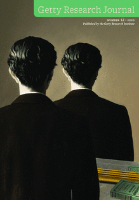
Getty Research Journal
Illuminating Cultural Heritage Through ResearchGetty Research Journal, published by University of Chicago Press, is an influential periodical in the fields of Conservation, History, Museology, and Visual Arts and Performing Arts. Established in the United States, this journal aims to foster scholarly discourse and advance research in the visual arts and cultural heritage, making it a vital resource for researchers, professionals, and students alike. While it holds a Q4 ranking across multiple disciplines in the 2023 category quartiles, indicating opportunities for growth and engagement, its unique focus on the interplay between art, history, and conservation provides a distinct platform for innovative ideas. The journal encompasses a diverse range of topics, encouraging interdisciplinary research that underscores the importance of the arts in society. As it converges years from 2015 to 2024, the Getty Research Journal serves not just as a publication, but as a dynamic forum for critical thought and exploration in the expansive realm of art and culture.
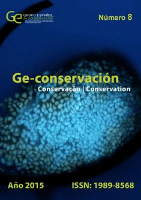
Ge-Conservacion
Shaping Conversations in Conservation and Art PreservationGe-Conservacion, published by GRUPO ESPANOL I I C, stands as a pivotal journal in the fields of Conservation, Museology, and Visual Arts and Performing Arts, facilitating an open-access platform since 2009. Based in Spain, this journal serves as a vital repository for innovative research and scholarly dialogue, significantly impacting the community with its Q1 and Q2 rankings across several categories in 2023. With an objective to advance multidisciplinary understanding and practices related to cultural heritage conservation, it attracts a diverse readership of researchers, professionals, and students eager to engage with contemporary issues and methodologies. The journal's commitment to accessibility enhances its reach and influence, making it an essential resource for anyone passionate about preserving the integrity and significance of our artistic and historical treasures.

BULLETIN MONUMENTAL
Preserving Heritage, Inspiring Scholarship.BULLETIN MONUMENTAL, published by the Société Française d'Archéologie Musée Monument Français, stands as a pivotal journal in the field of archaeology and architectural history. With its ISSN of 0007-473X, this journal features a rich compilation of research and insights dedicated to the preservation and study of France's monumental heritage. Although it is not currently open access, its contributions are critical for scholars, professionals, and students interested in the intersection of history, culture, and preservation practices. Covering a continuous period from 2002 to 2016, the journal has played an essential role in documenting advancements in archaeological methodology and conservation efforts, making it an invaluable resource in its field. Researchers seeking to deepen their understanding of architectural monuments in France will find BULLETIN MONUMENTAL a vital source of scholarly articles and field studies.

South African Journal of Art History
Championing Innovative Research in Art Historical StudiesSouth African Journal of Art History is a premier academic publication dedicated to the exploration and critical analysis of art history within the South African context. Published by the Art Historical Work Group South Africa (AHWG), this journal serves as a vital platform for researchers, professionals, and students alike to disseminate innovative research and engage with diverse perspectives on visual culture. With an ISSN of 0258-3542, the journal aims to elevate the study of art history, contributing significantly to the scholarly community's understanding of both local and international art narratives. Although currently not an open access journal, it is committed to high academic standards and in-depth scholarship, ensuring that each article published meets rigorous criteria. As South Africa continues to position itself at the forefront of global art discourse, the South African Journal of Art History stands out as a critical resource for anyone interested in the intersections of art, culture, and history within this dynamic region.
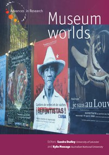
Museum Worlds
Innovating museum practices for a global audience.Museum Worlds is a distinguished academic journal published by BERGHAHN JOURNALS, dedicated to advancing scholarship in the fields of Museology and Conservation. With a strong impact within the academic community, evidenced by its 2023 Scopus rankings—#16 in Museology and #32 in Conservation—this journal offers an engaging platform for innovative research and discourse surrounding museum practices and cultural heritage. Since transitioning to Open Access in 2020, Museum Worlds has broadened its reach, making valuable insights available to researchers and practitioners globally. With its publication spanning from 2019 to 2023 and positioning in the top quartiles of respective categories, this journal is integral for those invested in the evolution of museum studies, providing a space for critical reflection, debate, and the sharing of pioneering methodologies in the stewardship of cultural institutions. Located in the heart of Brooklyn, NY, it stands as a hub for the scholarly community, inviting contributions that push the boundaries of knowledge in the ever-evolving landscape of museums.